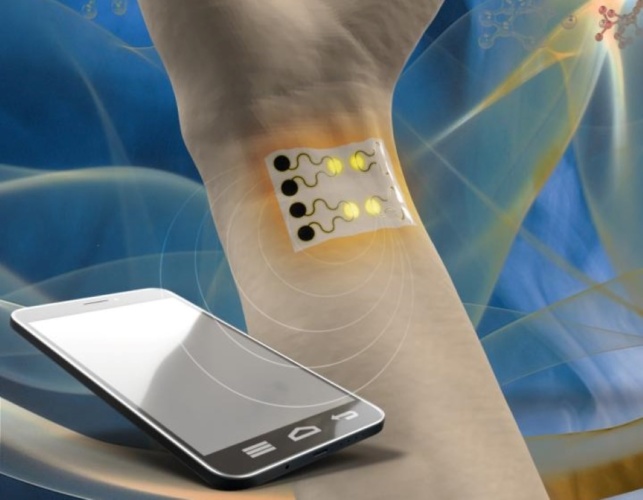
Developed by a team at Penn State and Northeastern University, the device is claimed to improve on existing wearable sensors because it uses a self-heating mechanism that enhances sensitivity and allows for quick recovery and reuse of the device. Other devices of this type require an external heater and are fabricated with an expensive and time-consuming lithography process under cleanroom conditions.
Graphene-based wearable sensors self-power to monitor vital signs
Wearable sensor measures glucose without need for finger-prick blood test
"People like to use nanomaterials for sensing because their large surface-to-volume ratio makes them highly sensitive," said Huanyu Cheng, assistant professor of engineering science and mechanics and materials science and engineering, Penn State. "The problem is the nanomaterial is not something we can easily hook up to with wires to receive the signal, necessitating the need for…interdigitated electrodes, which are like the digits on your hand."
Cheng and his team used a laser to pattern a highly porous single line of nanomaterial for sensors that detect gas, biomolecules, and in the future, chemicals. In the non-sensing portion of the device, the team created serpentine lines coated with silver. When they applied an electrical current to the silver, the gas sensing region heated up locally due to significantly larger electrical resistance, which eliminated the need for a separate heater. Furthermore, the serpentine lines allowed the device to stretch, allowing it to adjust to the flexing of the body for wearable sensors.
The nanomaterials used in the study are reduced graphene oxide and molybdenum disulfide, or a combination of the two; or a metal oxide composite consisting of a core of zinc oxide and a shell of copper oxide, representing the two classes of widely used gas sensor materials, namely low-dimensional and metal oxide nanomaterials.
"Using a CO2 laser, often found in machine shops, we can easily make multiple sensors on our platform," Cheng said in a statement. "We plan to have tens to a hundred sensors, each selective to a different molecule, like an electronic nose, to decode multiple components in a complex mixture."
The US Defense Threat Reduction Agency is interested in this wearable sensor to detect chemical and biological agents that could damage the nerves or lungs, according to the researchers. A medical device company is also working with the team to scale up production for patient health monitoring, including gaseous biomarker detection from the human body and environmental detection of pollutants that can affect the lungs.
Ning Yi, a doctoral student in Chen's lab and co-lead author of the paper posted online in the Journal of Materials Chemistry A, said, "In this paper, we showed that we could detect nitrogen dioxide, which is produced by vehicle emissions. We can also detect sulphur dioxide, which, together with nitrogen dioxide, causes acid rain. All these gases can be an issue in industrial safety."
The researchers said their next step is to create high-density arrays and try some ideas to improve the signal and make the sensors more selective. This may involve using machine learning to identify the distinct signals of individual molecules on the highly sensitive sensor platform.










McMurtry Spéirling defies gravity using fan downforce
What a fun demonstration. I wonder if they were brave enough to be in the car when it was first turned over. Racing fan cars would be an interesting...